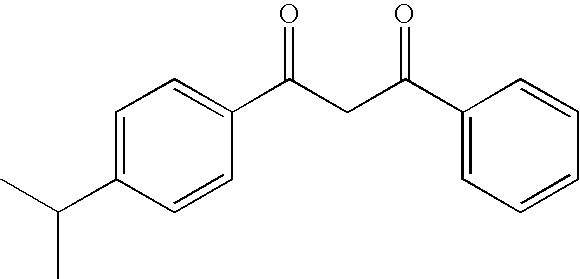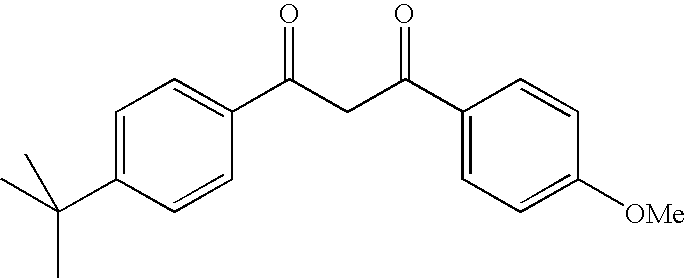UV-photoprotective compositions comprising diebenzoylmethane screening agents and silicon-containing s-triazine compounds substituted with two aminobenzoate or aminobenzamide groups
a technology of s-triazine and screening agent, which is applied in the direction of peptide preparation methods, animals/human peptides, peptide sources, etc., can solve the problems of premature aging of the skin, inducing impairment, and browning of the skin, and achieve the effect of improving the stability of at least one dibenzoylmethane compound
- Summary
- Abstract
- Description
- Claims
- Application Information
AI Technical Summary
Benefits of technology
Problems solved by technology
Method used
Image
Examples
synthesis examples
Example 1
Preparation of 2,4-bis(ethyl 4′-diylaminobenzoate)-6-{[1,3,3,3-tetramethyl-1-[(trimethylsilyl)oxy]disiloxanyl]propyl-3-ylamino}-s-triazine
[0199]
First Step
Preparation of 2,4-dichloro-6-{[1,3,3,3-tetramethyl-1-[(trimethylsilyl)oxy]disiloxanyl]propyl-3-ylamino}-s-triazine
[0200]1-amino-[1,3,3,3-tetramethyl-1-[(trimethylsilyl)oxy]disiloxanyl]-3-propane (41.7 g, 0.149 mol) and a solution of sodium bicarbonate (11.4 g, 0.135 mol) in 120 ml of water were added dropwise at 0° C. to a solution of cyanuryl chloride (25 g, 0.135 mol) in 250 ml of acetone so that the pH was from 3 and 6.5. Following introduction, the pH was 6.5. Stirring was then maintained for 1 hour 30 minutes at 10° C., then left at laboratory temperature. The precipitate formed was filtered, washed with water, drained and dried. 55.2 g (yield: 95%) of the expected derivative were obtained in the form of a white powder (MP: 59° C.).
Second Step
Preparation of Derivative of Example 1
[0201]A mixture of the above product ...
example 2
Preparation of 2,4-bis(n-butyl-4′-diylaminobenzoate)-6-{[1,3,3,3-tetramethyl-1-[(trimethylsilyl)oxy]disiloxanyl]propyl-3-ylamino}-s-triazine
[0204]
[0205]A mixture of the product from the first step of Example 1 (16.74 g, 0.0391 mol), butyl para-aminobenzoate (15 g, 0.0776 mol) and potassium carbonate (5.36 g, 0.0388 mol) was taken up in suspension in 170 ml of toluene with nitrogen bubbling through and heated under reflux for 1 hour 20 minutes. The reaction mixture was cooled and 150 ml of dichloromethane were added. The minerals were filtered. The filtrate was washed with bicarbonated water then twice with water. After drying the organic phase and evaporating off the solvents, a white powder was obtained. After recrystallization from a 1:15 EtOAc / heptane mixture, 20.1 g (yield: 69%) of the derivative of Example 2 were obtained in the form of a white powder:
[0206]MP: 110-111° C.
[0207]UV (ethanol): λmax=310 nm; E1%=1020.
example 3
Preparation of 2,4-bis(n-pentyl-4′-diylaminobenzoate)-6-{[1,3,3,3-tetramethyl-1-[(trimethylsilyl)oxy]disiloxanyl]propyl-3-ylamino}-s-triazine
[0208]
[0209]A mixture of the product from the first step of Example 1 (1 g, 2.3×10−3 mol), n-pentyl para-aminobenzoate (0.97 g, 4.6×103 mol) and sodium bicarbonate (0.39 g, 4.6×10−3 mol) in 15 ml of toluene was heated for 20 minutes to a temperature of 115° C. in a CEM Discover microwave oven at a power of 150 watts. Dichloromethane was added to the reaction mixture and it was washed with a saturated solution of sodium chloride then twice with water. After drying the organic phase and evaporating off the solvents, a transparent oil was obtained. After purifying on a silica column (eluent: heptane / EtOAc 85:15), the fractions of the derivative of Example 3 (0.9 g; yield: 50%) were recovered in the form of a white powder:
[0210]UV (ethanol): λmax=312 nm; E1%=1008.
PUM
| Property | Measurement | Unit |
|---|---|---|
| Fraction | aaaaa | aaaaa |
| Percent by mass | aaaaa | aaaaa |
| Fraction | aaaaa | aaaaa |
Abstract
Description
Claims
Application Information
 Login to View More
Login to View More - R&D
- Intellectual Property
- Life Sciences
- Materials
- Tech Scout
- Unparalleled Data Quality
- Higher Quality Content
- 60% Fewer Hallucinations
Browse by: Latest US Patents, China's latest patents, Technical Efficacy Thesaurus, Application Domain, Technology Topic, Popular Technical Reports.
© 2025 PatSnap. All rights reserved.Legal|Privacy policy|Modern Slavery Act Transparency Statement|Sitemap|About US| Contact US: help@patsnap.com



